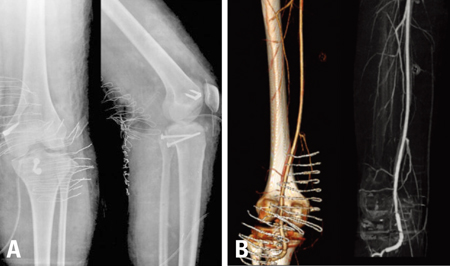Yonsei Med J.
2010 Sep;51(5):790-792. 10.3349/ymj.2010.51.5.790.
Vascular Injury Associated with Blunt Trauma without Dislocation of the Knee
- Affiliations
-
- 1Department of Thoracic Surgery, College of Medicine, Gyeongsang National University, Jinju, Korea.
- 2Department of Orthopaedic Surgery, College of Medicine, Gyeongsang National University, Jinju, Korea. hscspine@hanmail.net
- KMID: 1071436
- DOI: http://doi.org/10.3349/ymj.2010.51.5.790
Abstract
- Failure to recognize popliteal artery injury and restore vessel continuity of flow after blunt trauma is a major cause of lower extremity amputation and morbidity. A high index of suspicion and early recognition of the injury are paramount for limb salvage. We experienced a rare case of poplitial artery occlusion with the presence of arterial pulses due to collateral circulation after blunt trauma. Expeditious revascularization was achieved by using posterior approach, allowing two surgical teams to work simultaneously. This case illustrates that, even in the absence of knee dislocation, surgeons must always consider the possibility of a popliteal artery damage whenever a blunt trauma near the knee.
MeSH Terms
Figure
Reference
-
1. Varnell RM, Coldwell DM, Sangeorzan BJ, Johansen KH. Arterial injury complicating knee disruption. Third place winner: Conrad Jobst award. Am Surg. 1989. 55:699–704.2. Wagner WH, Calkins ER, Weaver FA, Goodwin JA, Myles RA, Yellin AE. Blunt popliteal artery trauma: one hundred consecutive injuries. J Vasc Surg. 1988. 7:736–743.
Article3. Kirby L, Abbas J, Brophy C. Recanalization of an occluded popliteal artery following posterior knee dislocation. Ann Vasc Surg. 1999. 13:622–624.
Article4. Chapman JA. Popliteal artery damage in closed injuries of the knee. J Bone Joint Surg Br. 1985. 67:420–423.
Article5. Drapanas T, Hewitt RL, Weichert RF 3rd, Smith AD. Civilian vascular injuries: a critical appraisal of three decades of management. Ann Surg. 1970. 172:351–360.6. Hollis JD, Daley BJ. 10-year review of knee dislocations: is arteriography always necessary? J Trauma. 2005. 59:672–675.7. Welling RE, Kakkasseril J, Cranley JJ. Complete dislocations of the knee with popliteal vascular injury. J Trauma. 1981. 21:450–453.8. Twaddle BC, Hunter JC, Chapman JR, Simonian PT, Escobedo EM. MRI in acute knee dislocation. A prospective study of clinical, MRI, and surgical findings. J Bone Joint Surg Br. 1996. 78:573–579.
- Full Text Links
- Actions
-
Cited
- CITED
-
- Close
- Share
- Similar articles
-
- Treatment of Multiple Ligaments Injuries
- Delayed diagnosis of popliteal artery injury after traumatic knee dislocation in Korea: a case report
- Duodenal Injury after Blunt Abdominal Trauma: Report of Two Cases
- Yvascular Injuries Associated with Fracture and Dislocastion of the Knee
- Spontaneously Resolved Lumbar Artery Injury after Blunt Trauma




